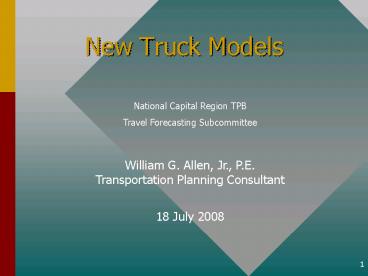New Truck Models - PowerPoint PPT Presentation
1 / 19
Title:
New Truck Models
Description:
Medium Truck: 2 axles, 6 tires (FHWA class 5) Heavy Truck: 3 axles (FHWA classes 4 and 6-13) ... Truck surveys don't work. Use new method developed for COM model ... – PowerPoint PPT presentation
Number of Views:58
Avg rating:3.0/5.0
Title: New Truck Models
1
New Truck Models
National Capital Region TPB Travel Forecasting
Subcommittee William G. Allen, Jr.,
P.E. Transportation Planning Consultant 18 July
2008
2
Timeline
- Feb. 04 Apr. 07 COM model developed
- 18 May 2007 COM presentation to TFS
- May 2007 truck models started
- Jan. 2008 truck models completed
- Jan. Jul. 08 TPB truck model testing
- 23 May 2008 TPB truck presentation to TFS
3
Vehicle Types
- Commercial Light-duty vehicle (car, van, pickup)
used for non-personal transportation - Medium Truck 2 axles, 6 tires (FHWA class 5)
- Heavy Truck 3 axles (FHWA classes 4 and 6-13)
- Includes Buses
4
Definitions
- Heavy Truck 3 axles, more than 6 tires
- Medium Truck 2 axle, 6 tires
- Commercial light duty vehicles used for business
5
Truck model history
- Original model developed from 1968 truck O-D
survey - Original truck types light, medium, heavy
- Models updated in 1985, based on limited count
data and 1968 survey
6
A new approach
- Truck surveys dont work
- Use new method developed for COM model
- Trip-based method consistent with current
modelling procedures - Borrow a starting model
- Use counts to synthesize more counts
- Use counts to adjust starting trips
- Use trip difference to refine the starting model
- Same method used for BMC, ARC, Ohio DOT
7
Truck Counts
- Primary data source MDOT counts
- 6 permanent counts
- 315 short-term counts
- Secondary data sources
- DC classification counts (11)
- Virginia classification counts (33)
- TPB 4-hour class. counts (148)
- (2003) TPB External Truck Survey (10 sites)
8
Daily truck count statistics
- Truck percentage MTK3.3, HTK3.2
- TRK range 0.9 to 26.1 (US 1 in Jessup, MD)
- TRK vol. range 27 14,700 (I-95, Howard Co.)
- Approx. TOD split 19 AM, 14 PM, 67 OP
9
Synthesized Counts
- Model HTK, MTK by link using count data
- Logit function TRK 1 / (1 eU)
- U ? lanes, facility type, area type, jurisdiction
- Apply to all links with counts
- TRK count est TRK count
- Thorough manual review
- Use actual counts where available
10
TRK analysis findings
- Synthesizing counts provides data for DC and VA
- TRK goes up with
- Less developed areas
- Higher facility types
- Increasing lanes (MTK) decreasing lanes (HTK)
11
Borrow a starting model
- Simple linear regression model, from BMC model
- Based on employment by type (industrial, office,
retail, other) and HHs - Adjustments for area type, truck zone
- Fs from BMC and Quick Response Freight Manual
- TOD percentages from MDOT count data
12
Truck Zones
- Zones with identifiable truck generators
- Business districts, warehouses, manufacturing,
transfer, airport, delivery - 1/0 flag
- 35 zones identified
- 3-5 times higher truck trip rate per job
13
Model Statistics
- Retail, Industrial empl are most important
- Higher trip rate (per empl) in less developed
areas - External share ? distance from cordon
- 2005 trip totals MTK474 K, HTK192 K,
total666 K - Avg. trip length MTK24 min., HTK58 min.,
total34 min. - Prior model 553K trips, 43 min. avg
14
Adaptable Assignment
Starting model
Starting trip table
Assign trips
Repeat (7 iter.)
Skim loads counts
Final trip table
Adjust trips
Delta trip table
Inform
15
Delta analysis
- Subtract starting trips from new trips
- Analyze trip end summary of difference
- Correlate with HH, employment
- Use to inform model (revise coeffs.)
- Keep delta table as adjustment
16
Calibration adjustment
- O/D table of mostly small adjustments
- Accounts for random error in assignment
- Table totals MTK7.8 K, HTK25.7 K
- Tend to be short trips no other pattern
- Carried along for forecasting, added to models
starting trip table
17
Validation results (2005)
- Prior model (v2.1D, fall 2005)
- RMSE 104, volume/count 1.16
- 553 K trips
- Starting model
- RMSE 111, volume/count 1.33
- 632 K trips
- Final model
- RMSE 51, volume/count 1.07
- 666 K trips
18
More results
- 2005 VMT
- Current 11.4 M
- New 10.8 M (-5)
- Trips go up, average length goes down
- 2030 estimate
- Trips 916 K (38)
- VMT 17.3 M (60)
19
Conclusions
- TPB wanted a cost-effective, practical, proven
approach - Goods movement approach not ready
- Truck trips are complex -- not suited to an
aggregate four-step approach - Truck travel is related to national policy and
macroeconomic factors beyond our knowledge - Dont wait 20 years to revisit the truck models































